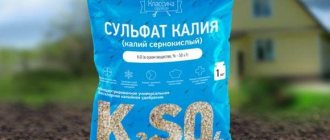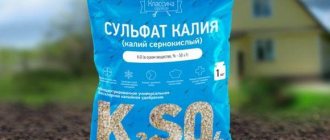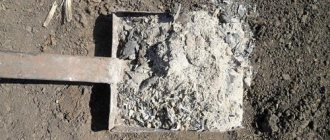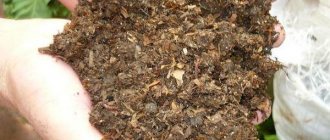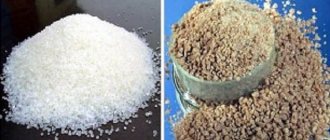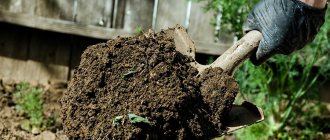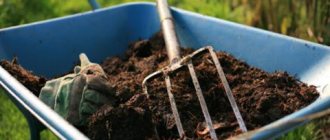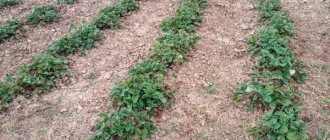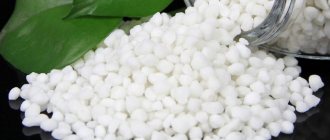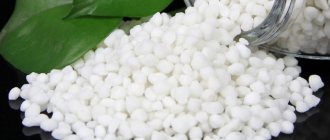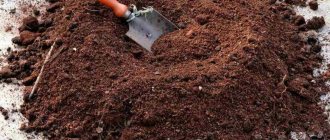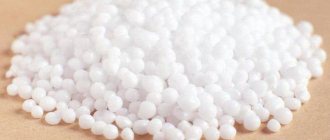Wood ash is a residue of mineral impurities formed during the combustion of wood or plant materials. It is a brown powder with fragments of charred branches. Ash contains a large number of useful compounds, which allows it to be used as a natural fertilizer. At the same time, it is an environmentally friendly substance that can be obtained independently using agricultural waste.
Compound
The composition of wood ash consists of a huge amount of mineral impurities.
Contents of the most important elements
| Element connections | Contents per 100 g |
| Calcium carbonate (CaCO3) | 17% |
| Calcium silicate (CaSiO3) | 16,5% |
| Calcium chloride (CaCl2) | 12% |
| Potassium orthophosphate (K3PO4 | 13% |
| Calcium sulfate (CaSO4) | 14% |
| Sodium orthophosphate (NaPO4) | 15% |
| Magnesium compounds | 4% |
| Sodium chloride (NaCl) | 0,5 % |
The chemical formula varies slightly depending on the type of wood being burned. The ashes of deciduous trees, young branches and fallen leaves are considered richer in mineral content compared to coniferous species. The powder obtained after burning green plants and grass contains less calcium compounds than wood residues. The components of wood ash have many beneficial functions.
On what soils is ash used and on what soils is it prohibited?
Ash will be an ideal fertilizer for the following type of soil:
- Low calcium soil.
- Soil with a high level of acidity (pH - less than 5.5), since the use of ash increases the acidity level.
Ash can increase the acidity of the soil so much that the ability of plants to absorb nutrients will decrease and the plantings will wither and die.
Properties of ash
With the help of wood ash in the form of fertilizer, gardeners enrich the soil with necessary components and regulate its Ph. These beneficial properties are enhanced by combining ash with peat, humus, and compost. The plants' need for a set of microelements is almost 100% satisfied due to the chemical composition of the ash. Each element formed in combustion products affects certain life processes occurring in plant tissues.
A high concentration of potassium in the ash allows increasing frost resistance in heat-loving crops. This is especially true when growing chrysanthemums, lilies, and roses.
Calcium derivatives have beneficial properties:
- Accelerate metabolism, thereby enhancing plant growth.
- Affect the absorption of nutrients.
- Activate photosynthesis processes.
- Affects the increase in green mass.
- Increases resistance to frost.
Magnesium compounds are a necessary trace element for the normal development of garden and vegetable crops. They affect cell metabolism. Thanks to this property, plant growth increases. In addition, magnesium is responsible for the sweet taste of vegetables and fruits.
Chlorides protect seedlings from fungal infections. They are able to extend the shelf life of harvested vegetables and fruits. In addition, they help to accumulate water in crops such as cucumbers and zucchini.
The benefits of mineral nutrition
Ash “works” more effectively in combination with other natural, organic soil fertilizers
The benefits of ash as a fertilizer are as follows. When entering it:
- acidic soil changes its composition from neutral or alkaline, which is necessary for most vegetable and garden crops;
- plants are quickly saturated with useful components, since they are contained in an accessible form;
- a whole “army” of pests dies;
- seedlings take root better and their adaptation to the external environment is painless;
- soil microorganisms decompose organic matter faster;
- fruiting of plants on heavy soils improves.
Wood ash works more effectively if you mix it with peat, compost, and humus before adding it. This combination reduces acidity and creates looser soil. Compost matures faster when ash is added to it in advance. The mixture is stored in compost heaps.
Macro- and microelements are included in the ash concentrate in the form of various salts: sulfates, carbonates, chlorides, silicates, orthophosphates, forming other chemical combinations. Salts and alkalis reduce the acidity of the soil, increasing the pH level.
Garden compost matures faster when ash is added to it.
Ash as a fertilizer has a number of advantages compared to other inorganic compounds. Ash properties:
- ease of preparation and low cost;
- environmental friendliness, safety for people and plants;
- replenishment of nutritional deficiencies;
- balanced composition;
- easily accessible to plants;
- suitable for most garden crops;
- shelf-life Unlimited;
- You don't have to worry about overdosing.
A product such as fireproof pieces of coal in ash also brings benefits. Its small fragments are an excellent fertilizer for flowers. Used in the substrate when planting cacti, orchids, aroids and succulents. This is an antiseptic that, in crushed form, is applied to places of cuts or wounds in plants, ridding unprotected areas of pathogenic microorganisms.
Use of wood ash
The most common use of coal is in agriculture. Ash obtained from burning wood residues is recommended for use in the following cases:
- shedding of leaves on grapes;
- cracking of carrot fruits;
- premature rotting of fruits;
- potatoes and tomatoes turn black;
- mold on strawberries;
- signs of fungal diseases on the leaves.
In addition, soot is used as a universal fertilizer, soil pH regulator, and protection against insect pests.
Using ash against diseases and insects
Wood ash in the country is successfully used when:
- powdery or downy mildew;
- rot;
- cabbage midges, Colorado potato beetles;
- ants and slugs.
As soon as the first signs of fungal diseases are detected on the leaves of the seedlings, an ash mixture is used. To prepare it, 2-3 kg of ash is diluted with 10 liters of water. Leave in a warm place for several days. The resulting ash infusion is used to irrigate the shoots for 3-4 days, then take a break for 15-20 days and repeat the procedure. The addition of grated laundry soap enhances the effect.
Dry ash is not liked by various garden pests, especially snails and slugs. The protective properties of ash are enhanced when combined with tobacco dust in equal parts. It is sprayed in places where insects accumulate at the rate of 200-300 grams of product per 1 m2.
Stimulating plant growth with ash solution
The combustion products of wood raw materials are often used as a natural stimulator of seed germination. Soaking in an ash solution activates the internal resources of the grain. The ashes are diluted with boiled water in a ratio of 1:10. The solution is left in a dark place for 2-3 days. The seeds are soaked in the resulting solution, preferably overnight. This method of increasing germination is used when germinating cucumbers, cabbage, eggplants, and tomatoes.
What garden plants are they used for?
Depending on the purpose of use, it can give different results. By fertilizing seedlings or young growth, you can achieve more intensive growth. And when applied during the flowering or fruit formation period, the productivity of garden crops can be improved.
Suitable for almost all crops: root crops, melons, cruciferous and nightshade crops.
For seedlings
In addition to soaking planting material, it can be used dry to accelerate growth. Only used at the stage of transplanting into garden holes. During the planting process, 5-10 g of ash, previously mixed with soil, is poured into each hole, and seedlings are planted on top.
For potatoes
Potatoes are fed several times a season. The first application of the combustion product is carried out in the spring during digging. Apply 1 cup per square meter of area.
The second application is for planting tubers. Then add 3 tablespoons of plant fertilizer to all holes. With each hilling it is useful to add infusion. Proportions: 0.4 ml per plant.
For cucumbers, squash
Ash containing calcium and potassium is necessary for these crops for the intensive formation of shoots and ovaries. Feeding is carried out according to a certain scheme:
- First (immediately before sowing), the row spacing is filled at the rate of 50 g per 1 square meter. m area.
- At the stage of bud formation, the bushes are watered with infusion 3 times a month. Calculation: 0.5 liters of infusion for each bush.
- Adults spray until a coating forms on the leaves.
For tomatoes and peppers
To improve growth and faster formation of ovaries, tomatoes need to be “fed” 3 times during the summer.
- First, dry is added at the stage of forming the beds. The quantity is distributed in the following way: for every 1 sq. m of sown area will need half a cup.
- Then, when planting the seedlings, you need to add a handful of a mixture of ash and substrate to each hole.
- The third stage is during growth and fruit set. For each plant, calculate 1 liter of water infused with plant fertilizer.
Red peppers are fed a little differently. It is introduced during spring digging. The dosage is calculated as follows: for every 1 sq.m. – 0.6 kg. When planting peppers, pour a glass of a mixture of earth and ash into each hole.
For zucchini
Zucchini, like all pumpkin crops, is fed several times a season. The proportions depend on the stage of cultivation.
- The first time before disembarkation - for 1 square. m area take 200 g of substance. When planting, pour 12 g into each hole.
- Then - during the flowering period. At this stage, for every 1 sq. m need to be poured into a glass, then poured with water.
For cabbage
Cabbage, which is part of the cruciferous family, is fed with this substance at the stage of forming the bed. Spray 2 cups of ash onto each square meter. During planting, 1 handful of this fertilizer is poured into each hole.
If the weather is wet, cabbage needs additional protection from caterpillars and slugs. To do this, you can spray it with infusion, repeating this procedure several times.
For carrots and beets
Root crops are “fed” for the first time when digging up the ground. Approximately 1 cup of plant fertilizer is applied to each square meter of area. After seed germination, the young plants are sprinkled twice a month during irrigation.
Use of ash as fertilizer
Advantages of ash as a fertilizer compared to other complexes:
- easy to make yourself;
- cheapness;
- safe for health;
- balanced composition;
- Most plants can be fertilized;
- there is no expiration date.
- there is no need to strictly adhere to a certain concentration of the solution.
Wood soot is an excellent fertilizer for various garden crops. In addition, it can be used to improve the chemical composition of the earth.
You can loosen the soil and adjust its acidity by digging it together with the ash. Use a mineral product as a Ph regulator after conducting an appropriate test. The study is carried out using litmus paper or folk remedies: soda or acetic acid.
An aqueous solution of ash is sprayed with a spray bottle, thereby protecting the plantings from insect pests. For a long-term effect, add 50 grams of grated laundry soap.
Dry powder is used to dust the potatoes before planting. Ash scattered on the beds will reliably protect the crop from snails, slugs, and prevent infection with fungal infections.
Added to humus or compost, wood soot accelerates the ripening process of the fertilizer, further enriching it with the necessary microelements.
What should not be mixed with and why
There are a number of contraindications for use. It cannot be mixed with some substances and fertilizers. It is prohibited to combine with any nitrogenous fertilizers.
It is not advisable to use it simultaneously with superphosphate, manure or bird droppings. The combined use of these substances may cause an undesirable reaction, so they must be used separately from each other.
If the soil is carbonate in composition, it is undesirable to use it. This combination can cause an alkaline reaction, which may be unfavorable for the future harvest.
How to apply fertilizer
It is necessary to add ash to the soil when digging it in early spring after the snow melts. This measure prevents the leaching of calcium along with melt water. Heavy soils are an exception to this rule. Fertilizer is applied to them in the fall. About 150-200 grams of charcoal are used per 1 m2.
As a dry fertilizer, ash is added along the edge of the hole, mixed with soil. Do not sprinkle ashes directly into the hole. Contact with young roots can cause chemical burns. You can lightly dust the stems of the sprouts with ash. The amount of ash is approximately 0.5 cups for just planted seedlings. For older crops, the volume is increased to 2 cups.
Liquid fertilizer can be used immediately without additional infusion. It's quite easy to prepare. To do this, dilute 200-300 grams of ash in 10 liters of water. The product used can be used every 15-20 days throughout the entire gardening season, best in dry, windless weather.
Types of fertilizing
Ash as a fertilizer: it is applied in the form of dry raw materials or liquid mixtures
Natural fertilizer is well absorbed in any form , it all depends on the specific situation, capabilities and preferences of the gardener.
Ash ash is introduced into the soil during plowing, during planting, and is also used as top dressing during the growing season.
Dry ash mixture
Dry ash acts as a top dressing and at the same time repels some pests and serves as a preventative against diseases.
It is applied during the growth period of cultivated plants several times per season. This is the simplest way to use:
- the ash is poured under the root;
- lightly embedded in the soil;
- water abundantly.
Ash ash is sprinkled on the beds, applied into holes, between rows, under bushes and trees in a small layer, or dusted on plants. In this case, natural fertilizer “works” as a preventative agent in the fight against pests and diseases.
Preparation of ash decoctions and infusions
Preparation of ash solution
Knowing how to use ash as fertilizer in the garden and garden, you can significantly increase the yield of vegetable, flower, and fruit crops.
To prepare solutions in the required proportions, we use the table: “Weight of ash in different containers”
Ash-based mixtures are prepared in advance. You can’t just pour natural fertilizer into water and water crops with it. Vegetable growers infuse ash using different recipes.
Ash to increase the yield of peppers
Recipe No. 1.
- Prepare a 200 liter barrel. Pour a 10-liter bucket of ash into it. If this dosage is large, then another option: 1 liter of ash is diluted in 20 liters of liquid
- The barrel is placed for 2-3 days (according to other sources: up to 7 days) in a sunny, warm place. The composition must be stirred regularly
- After 3 days, the infusion is diluted 1:1. Plants are watered or evenly sprayed with it in dry weather.
Recipe No. 2.
- Pour 3 liters of ash into a 10-liter bucket and dilute with a small amount of water
- The mixture is brought to 10 l and stirred
- Leave for 2-3 days
- Dilute with water 1:1 and use as directed
It is convenient to prepare the infusion in a barrel, which is located on the site. The prepared “mineral elixir” is convenient for feeding the bulk of garden crops
For foliar feeding, sifted ash is initially used. The solution is filtered, removing the cloudy residue. The missing volume is added to 10 liters. This is a masterbatch that should be diluted.
A 1 liter jar is diluted with 10 liters of water and this “nutrient elixir” is sprayed over the leaf. The elements are quickly absorbed, which has a beneficial effect on the development of the plant as a whole.
For root feeding from the resulting mother infusion, 1 liter jar is diluted in a 10 liter bucket of water. Water the soil under garden and vegetable crops, being careful not to get the mixture on the stems and leaves. During infusion, water-soluble elements from the ash flour pass into the solution, turning it into a nutrient mixture.
Nutrients are well preserved in the decoction:
- Pour 3 kg of ash into a metal container (basin, bucket) and pour 10 liters of boiling water.
- Boil for half an hour
- Cool, filter, bring to 10 l
- Take a liter jar from the mother broth and dilute it in 10 liters of water.
- Rub 30-40 g of laundry soap into shavings and add to the solution. Thanks to soap, the decoction is better retained on the surface of the leaf blade
Not only vegetable but also flower crops are responsive to foliar feeding with ash infusions
Ash is a chemically active substance, so it must be used separately from other fertilizers. It is not advisable to combine it with ammonium nitrate, urea or manure, which contain a lot of nitrogen. They neutralize each other's action.
Contraindications for using ash
Ash is a universal remedy, but it is not always possible to use it, and in some cases it is even harmful. Charcoal reduces the acidity of the soil, as a result, it should not be used in low or normal soil pH. Plants that prefer acidic soil should not be fertilized with soot. These include:
- conifers;
- camellias;
- rhododendrons;
- heather;
- sorrel;
- radish;
- watermelon;
- orchids and violets.
An overdose of fertilizers has a bad effect on the growth and development of seedlings. Excess minerals can be determined by the appearance of the garden crop. So, too much calcium is indicated by:
- early drying of tomato shoots;
- rapid growth of leaves on apple trees and grapevines;
- chlorosis on pink leaves;
- shedding of flower leaves.
A large amount of potassium leads to:
- the appearance of dark pulp on apples and pears;
- bitter taste of fruits;
- shedding of leaves.
Charcoal is incompatible with nitrogen fertilizers. Under its influence, the effect of nitrogen is neutralized, and the seedlings cease to receive the necessary nutrients. If necessary, fertilizing can be carried out at different periods: one fertilizer in the fall, and another in the spring.
Phosphorus compounds should also not be combined with ash. This makes it difficult for plantings to absorb micronutrients and impairs their development.
Universal recipes for ash feeding
Soaking the seeds
Use only the following solution:
- the ashes are diluted with water in a ratio of 1 tsp. per 1 liter of liquid;
- insist for a day;
- soak the seeds for 5-6 hours before sowing.
Soaking seeds in an ash solution is considered a way to disinfect seed material and accelerate seed germination.
Adding to soil
Dry ash is mixed with soil to improve its quality composition. For this:
- the soil is loosened and holes are made;
- mix earth and ashes in a 1:1 ratio;
- the resulting composition is poured onto the bottom of the hole.
Adding ash directly to the soil is one of the methods of soil deoxidation.
Fertilizer
Use an ash solution prepared according to the classic recipe for 3-5 hours. If the goal is to feed the plants without additional disease control, then you can prepare a “quick” solution:
- sift the ash;
- For 1 liter of warm water take 2 tbsp. ash;
- mix well and pour under the root.
Useful tips
If you have a stove or fireplace at your dacha for burning wood, do not throw away the ash under any circumstances. It is suitable for feeding almost any plants in the garden, both during planting and during the formation of ovaries. In fact, ash is an organic analogue of superphosphate, which is why it is so widely used.
However, it should be remembered that only ash of organic origin should be used: ash obtained from the disposal of household waste will not only not bring the desired result, but can also harm crops.
The features of using ash as a fertilizer are discussed in detail in the video.
How to fight pests and plant diseases with ash
Wood ash is useful not only as a fertilizer. An ash-soap solution is an extremely cheap, effective and completely safe means for controlling garden pests. It is prepared as follows:
- 300 g of sifted ash is poured with boiling water and boiled for half an hour;
- filter and pour into a bucket of water;
- for better adhesion, add 50 g of laundry soap.
Spraying is carried out in the evening, in dry weather, trying to get on both sides of the leaves. The product is effective against all sucking insects - aphids, fleas, ticks and others.
Treatment with an ash-soap solution does not harm plants and flying beneficial insects, so it can be carried out frequently. If you add tobacco dust to this solution, the infusion will help repel the Colorado potato beetle and its larvae from potato plantings.
A mixture of sifted ash and tobacco dust is used to dust onion plantings against onion flies and cabbage against cruciferous flea beetles.
An infusion of wood ash protects blackcurrants and gooseberries from sawfly larvae, moths, aphids and powdery mildew. To prepare, pour a half-liter jar of ash into a bucket of hot water and leave for two days.
To protect cabbage from flea beetles and strawberries from slugs, dusting the beds with dry ash helps.
Ash in a cat's diet
Many cat lovers, reading the composition of pet food, wondered why it contains ash? The fact is that the mineral elements that are found in it are equally necessary for both plants and animals. Therefore, ash in cat food allows them to replenish their reserves. Microelements are needed for normal hair growth, strengthening bones and teeth, they are involved in digestion and metabolism. If your pet constantly tries to chew on inedible objects, treat him to food that contains ash. These foods should be given with caution to cats with urolithiasis. For sick animals, you should choose a diet based on natural products.
Proper storage of ash fertilizers
The ashes should be scooped out of the oven with a large scoop and placed in a dish without cracks to avoid the ingress of excess moisture. Gardeners recommend building a fire either on a sheet of iron or in a metal fireproof container. This way it will be as convenient as possible to collect ash. And the best thing is to place a metal mesh there, where you put all the organic matter before setting it on fire. After the end of combustion, large residues are easily separated from fine ash.
You should not delay collecting ashes. The longer it sits in the air, the more nutritional properties it will lose due to exposure to moisture. The collected ash should be kept in an airtight container to prevent it from becoming damp. It is advisable to choose a cool, dark place for long-term storage.
Ash obtained as a result of combustion of the following objects is absolutely not suitable for feeding:
- Plastic, newspapers and magazines, polyethylene, rubber and other household waste. Such ash will not only not help the plant, but will also easily cause the death of the plantings.
- Organic matter collected along major highways and industrial sites. Most likely, such ash will contain increased levels of lead concentration.
- Wooden boards, furniture made of wood or chipboard. The ash will certainly contain remnants of varnish, paint and glue, which could have been used to connect the elements of objects.
Under suitable conditions, ash can be stored from 6 months to several years. The main thing is to prevent moisture from entering, otherwise some of the beneficial properties will be lost. Due to getting wet, potassium will evaporate first.
Ash from fuel briquettes, as a rule, can be used as ordinary ash to deoxidize the soil for planting vegetables. True, you definitely need to look at the composition, since sometimes unscrupulous manufacturers use glue to prevent the product from falling apart. In this case it cannot be used. Ash from briquettes should not be used as fertilizer.
Indications and contraindications for use
The use of ash is indicated on acidic or podzolic soils to restore the balance of acidic and alkaline microelements. There are plants that prefer acidic soils, but most berry and vegetable crops grow well in slightly acidic soils.
A slightly acidic reaction is necessary to dissolve some nutrients. For example, phosphorus in an alkaline environment turns into inaccessible compounds and does not benefit plants.
Ash fertilizer does not contain chlorine, so it is recommended for those plants whose growth is inhibited by chlorine compounds. It takes time to eliminate it from the soil, so chloride compounds are used mainly in the fall.
If a nutrient deficiency occurs in spring or summer, then the best way to feed the crops will be an infusion of ash to feed the plants. You can make it a week in advance by filling it with water and waiting until most of the microelements turn into liquid.
If you regularly use urea, the plants will grow green mass well. At the same time, they will not be able to bloom and set fruit, since all the energy will go into the growth of leaves and shoots. In order to have a balance of nutrients, you need potassium and phosphorus, then the harvest is guaranteed to be high.
A contraindication for fertilizing with ash is high soil pH. If liming of the soil was carried out, then wood ash is not used for 1 - 2 years. And:
- You cannot add ash and phosphates at the same time;
- use ash obtained from garbage - plastic, rubber, painted wood - in the garden;
- You cannot apply nitrogen fertilizers and ash at the same time, since these substances neutralize each other’s effects, that is, the acid is neutralized by the alkali;
- There will be no benefit from ashes that have been stored for a long time in the open air; rain washes nutrients into the soil.
There are rules and recommendations for the preparation and storage of the substance.
Benefits against plant pests
When the soil becomes acidified, plants lose their immunity because they cannot feed properly and distribute substances in the tissues. Fungal diseases are the main scourge of gardeners.
The spores spread quickly and can destroy an entire crop in a week. To prevent this from happening, it is better to regularly water the soil with ash infusion and also spray the leaves.
The alkali prevents insects such as ants, snails or slugs from approaching the plantings. The invasion can be stopped by sprinkling dry ash around the crops. Slugs get burned and die crawling through the ashes.
If you provide proper nutrition to plants, they themselves strengthen their own immunity and can fight pests with the help of synthesized chemical compounds.
